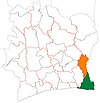Grand-Bassam
- View a machine-translated version of the French article.
- Machine translation, like DeepL or Google Translate, is a useful starting point for translations, but translators must revise errors as necessary and confirm that the translation is accurate, rather than simply copy-pasting machine-translated text into the English Wikipedia.
- Do not translate text that appears unreliable or low-quality. If possible, verify the text with references provided in the foreign-language article.
- You must provide copyright attribution in the edit summary accompanying your translation by providing an interlanguage link to the source of your translation. A model attribution edit summary is
Content in this edit is translated from the existing French Wikipedia article at [[:fr:Grand-Bassam]]; see its history for attribution. - You may also add the template
{{Translated|fr|Grand-Bassam}}to the talk page. - For more guidance, see Wikipedia:Translation.
Grand-Bassam (French pronunciation: [ɡʁɑ̃ basam]) is a town in southeastern Ivory Coast, lying east of Abidjan. It is a sub-prefecture of and the seat of Grand-Bassam Department; it is also a commune. During the late 19th century, Grand-Bassam was briefly the French colonial capital of Ivory Coast. Because of its outstanding examples of colonial architecture and town-planning, and the juxtaposition of the colonial town with a traditional Nzema village, the historic center of Grand-Bassam was designated a UNESCO World Heritage Site in 2012.[5]
In 2021, the population of the sub-prefecture of Grand-Bassam was 124,567.[3]
Geography
The town is divided by the Ébrié Lagoon into two-halves: Ancien Bassam is the former French settlement, facing the Gulf of Guinea. It is home to the grander colonial buildings, some of which have been restored. The district is also home to a cathedral and the Ivory Coast National Museum of Costume, located in the former Governor's Palace.[5] Nouveau Bassam, linked to Ancien Bassam by a bridge, lies on the inland, northern side of the lagoon. It grew from the African servants' quarters and is now the main commercial centre of the town.
The town is the seat of the Roman Catholic Diocese of Grand-Bassam. The diocese's cathedral is the Cathédrale Sacré Cœur in Grand-Bassam.
History
The name Bassam may come from an ancient African word for the mouth of the Comoé River.[6] Inhabited by the Nzema people since the 15th century, the city grew into a profitable fishing village and a trading center.[6] In 1843, after signing a treaty with the African ruler of the Grand-Bassam region, the French built Fort Memours on the banks of the river.[6] This fort became the primary French trading point in the region, and after the Berlin Conference in 1885, became a base for exploration of West Africa by the colonoizers. In 1893, Grand-Bassam became the capital for the French Colonie de Côte d’Ivoire.
In 1899, the administration was transferred to Bingerville after a devastating bout of yellow fever, in which 3/4 of the population died.[5][6] However, the town remained a key seaport until the growth of Abidjan from the 1930s. The town has the aura of a ghost town, since large sections have been abandoned for decades. In 1896, the French capital was moved to Bingerville, and commercial shipping gradually declined until it virtually ceased in the 1930s. In 1960, with independence, all remaining administrative offices were transferred to Abidjan, and for many years Grand-Bassam was inhabited only by squatters. Beginning in the late 1970s, the town began to revive as a tourist destination and craft centre.
In March 2016, the town was targeted in an Islamist mass shooting which killed 19 people.[7][8]
Sports
Villages
The eight villages of the sub-prefecture of Grand-Bassam and their population in 2014 were:[9]
- Azuretti (1 168)
- Ebrah (805)
- Gbamblé (341)
- Grand-Bassam (74 671)
- Modeste (1 981)
- Mondoukou (1 400)
- Vitré 1 (2 482)
- Vitré 2 (1 180)
References
- ^ "Ivory Coast Cities Longitude & Latitude". Sphereinfo.com. Archived from the original on 13 September 2012. Retrieved 19 November 2010.
- ^ Citypopulation.de Population of cities & localities in Ivory Coast
- ^ a b Citypopulation.de Population of the regions and sub-prefectures of Ivory Coast
- ^ "Grand Bassam". Ramsar Sites Information Service. Retrieved 25 April 2018.
- ^ a b c "Historic Town of Grand-Bassam". UNESCO World Heritage Centre. United Nations Educational, Scientific, and Cultural Organization. Retrieved 27 August 2017.
- ^ a b c d Grand-Bassam (Côte d’Ivoire): No. 1322rev (Report). International Council on Monuments and Sites. 14 March 2012. Retrieved 16 May 2021.
- ^ Tran, Mark; Duval Smith, Alex (13 March 2016). "'At Least 16 Dead' After Gunmen Open Fire in Ivory Coast Resort". The Guardian. Retrieved 13 March 2016.
- ^ Reuters
- ^ "RGPH 2014, Répertoire des localités, Région Sud-Comoé" (PDF). ins.ci. Retrieved 5 August 2019.
External links
 Grand-Bassam travel guide from Wikivoyage
Grand-Bassam travel guide from Wikivoyage
- v
- t
- e











